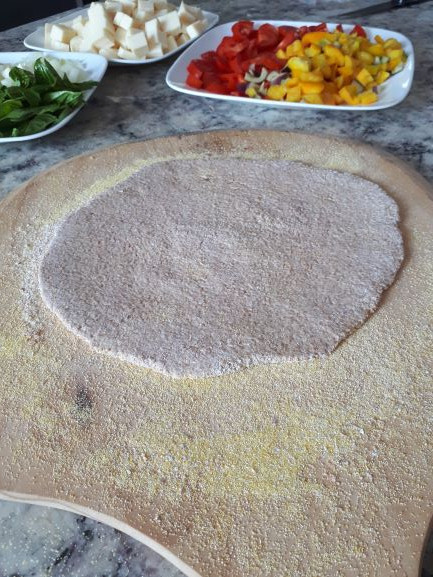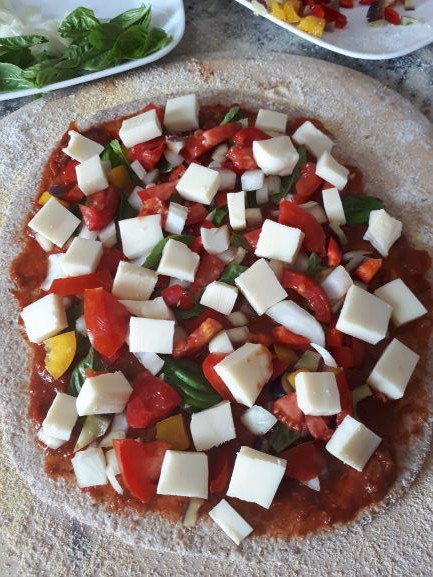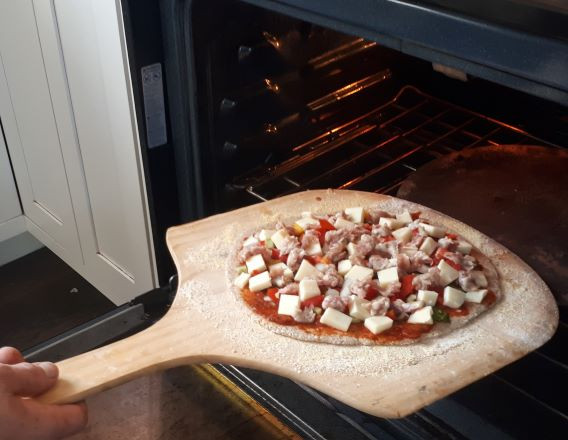Red Fife Fermented Pizza Dough
Ingredients
3 cups Lukewarm water
1 Tbsp Dry Active Yeast
1 Tbsp Salt
2 Tbsp Honey (or sugar of choice)
1/8 cup Olive Oil
2 Tbsp Apple Cider Vinegar
8-9 cups Jubilee Red Fife Flour (you may need to add more flour if your dough is too sticky to handle)
Instructions
- Mixing & Storing the Dough: Mix the yeast, salt, sweetener, olive oil and apple cider vinegar with the water in a 5-quart bowl or a lidded (not airtight) food container (I use my crockpot with lid).
- Mix in the remaining dry ingredients without kneading, using a spoon or a stand mixer. If not using a machine, you may need to use your hands to incorporate the last bit of flour.
- Cover (not airtight) and allow it to rest at room temperature for 12-24 hours.
- The dough can be used after resting but it is easier to handle when cold. Refrigerate it in a lidded (not airtight) container and use for pizza or flatbread over the next 7 days (the fermented taste will increase as the week progresses). Or store the dough for up to 4 weeks in the freezer in 1/2 pound portions. When using frozen dough, thaw it in the refrigerator overnight before use.
Baking Instructions
This is how we make a delicious thin crust pizza. There's lots of ways to bake a pizza out there, feel free to bake however you like, this is just how we do it:
Directions
- Prepare your toppings in advance. Thirty minutes before you're ready to bake, preheat a baking stone at your oven's highest temperature, placed in the bottom third of the oven.
- Prepare a pizza peel with flour or cornmeal to prevent pizza from sticking to
it when you slide it into the oven. - Divide 1 lb of dough into two balls. Sprinkle the surface of your dough balls with flour so they won't stick to your hands. Roll out your first dough ball onto your prepared pizza peel to produce a 1/8-inch-thick round. When you're finished the dough round will be about 10 inches across, and should have enough flour or cornmeal under it to move easily when you shake the peel.
- Add the toppings. We prefer using well-spaced chunks of cheese, which gradually melt and spread (giving the crust a longer opportunity to crisp before the toppings burn).
- Slide the pizza onto the preheated stone. This can sometimes be a challenge. With practice it gets easier! As the pizza is cooking, we start preparing our second pizza.
- Check for doneness in 8 to 10 minutes. Once done, use a spatula to transfer the pizza onto a plate or baking sheet.
- Allow to cool slightly so the cheese sets. Buon appetito!
Why such small pizzas? Start with pizza this small because they're much easier to handle when your learning the method. As you become confident that your pizza won't stick to the peel when you slide it in, you can use the whole dough ball to make a large pizza.
How much topping should I use on Pizza?
Thin crusted pizzas, with dough stretched to 1/8 inch thick or less, come out better if you use less topping. Lightly topped pizzas develop crisper crusts and are easier to slide off the pizza peel.
What is the key to success in sliding a pizza off a Peel?
Timing is key here, the longer the dough sits of the pizza peel, the more likely it is to stick. Prepare and measure all your toppings in advance. Dust the pizza peel with more flour or cornmeal before laying the dough onto it. Top quickly and top lightly- the more you use, the heavier the dough will sit on the peel.
For the most reliable slide, place the tip of the peel near the back of the stone, close to where you want the far edge of the pizza to land. Give the peel a few quick forward-and-back jiggles and pull it sharply out from under the pizza. If you still aren't confident, build your pizza on parchment paper- the parchment slides right onto the stone with the pizza and can be removed halfway through the baking sheet and you won't have to do any sliding at all.
Help, my pizza dough is stuck to the peel!
- Locate where the dough is sticking by shaking the peel and watching how the dough moves. The dough will move but not around the stuck spot.
- Sprinkle a little flour on the peel next to the spot that is stuck. Using a dough scraper, held at a shallow angle, push the flour under the dough, lifting it by moving toward the centre as far as necessary to unstick the spot that isn't moving.
- Shake the peel again to confirm your success. If it's still not moving repeat.
How do you protect toppings from scorching and burning?
If a topping is burning before the rest of the pizza is finished, there's an easy solution: protect it with cheese. Just change the order for applying toppings.
I'm afraid of sliding pizzas off a pizza peel. Can I assemble and bake pizza right on a non-preheated baking sheet?
Absolutely! Though we think the crust isn't quite as crisp when done this way, it's a nice alternative for achieving delicious pizza without the need to slide your pizza off a peel. It's also a handy way to make really large pizzas, which are tricky to slide into the oven. Heavy-gauge aluminum sheets are the best, especially those with short-rimmed sides to contain any errant toppings. They're known in the baking trade as "half sheets", or jelly-roll pans. Aluminum heats up quickly in the oven and it's that sudden heating that gives you a crisp crust. Here's what you do:
- Generously grease a heavy-gauge baking sheet with oil.
- Stretch your dough and place it on the baking sheet; roll out further to a 1/8 thickness.
- Cover with toppings and place into a preheated oven on a low shelf. Baking time may increase slightly.
*Pizza directions and tips credit to Jeff Hertzberg and Zoe Francois authors of Artisan Pizza and Flatbread in Five Minutes a Day





